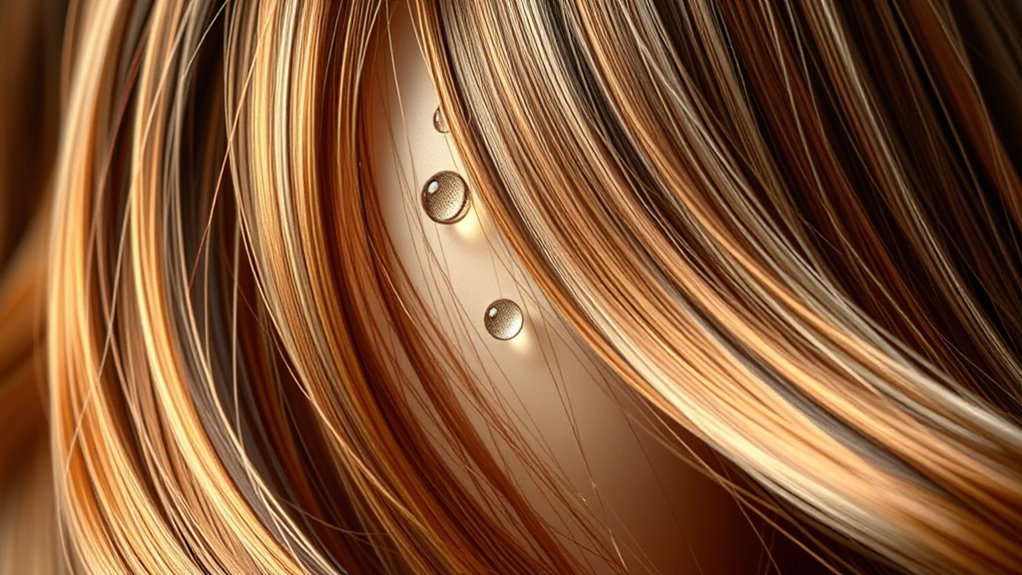I Swapped My Night Cream for This Natural Oil
Swapping your night cream for a natural oil can truly transform your skincare routine. These oils are packed with vitamins, antioxidants, and essential fatty acids that hydrate and nourish your skin deeply. They’re also great at combating free radicals and soothing irritation. Just pick the right oil for your skin type, apply it at night, and watch your skin glow with health. There’s so much more to explore about the benefits and application techniques!
Key Takeaways
- Natural oils provide hydration and anti-aging benefits, making them a healthier alternative to traditional night creams.
- Transitioning to oil requires selecting the right type based on individual skin concerns and needs.
- Oils like argan, jojoba, and rosehip are effective options tailored for various skin types.
- Gradually incorporating oil into your routine enhances skin adjustment and allows for better observation of results.
- Consistent use of natural oils can lead to nourished, balanced skin over time, surpassing initial hesitations.
The Journey to Natural Skincare
As you explore the world of skincare, you’ll quickly discover that the shift toward natural products isn’t just a trend; it’s a journey toward healthier choices.
This journey often starts with simple steps, like swapping your conventional night cream for a natural night oil. You might notice how these oils are packed with nourishing ingredients, providing your skin with essential vitamins and antioxidants. They absorb quickly, delivering hydration without clogging pores, which is a game-changer for many.
Plus, using a natural night oil allows you to embrace sustainability, as many brands focus on eco-friendly practices. Additionally, embracing natural night oils can significantly enhance your skin’s rejuvenation process, leading to a more radiant complexion.
As you delve deeper, you’ll find that this transition not only benefits your skin but also promotes a more conscious approach to beauty.
Understanding the Benefits of Natural Oils
Natural oils are packed with nutrients that can transform your skincare routine. Their versatile applications mean you can use them for hydration, healing, and even anti-aging benefits. Understanding how these oils work can help you make the most of their potential for your skin. For instance, incorporating natural face oils can enhance your skin’s overall texture and radiance.
Nutrient-Rich Composition
When you choose a night cream infused with natural oils, you’re tapping into a powerhouse of nutrients that can transform your skincare routine.
These oils, rich in vitamins, antioxidants, and essential fatty acids, nourish your skin while you sleep. For instance, oils like argan and jojoba provide hydration and improve elasticity, giving your complexion a youthful glow.
Vitamin E, found in many natural oils, helps combat free radicals, promoting healthier skin overall. Additionally, the anti-inflammatory properties of oils like rosehip can soothe irritation and redness, making them suitable for all skin types.
Versatile Skin Applications
While many people think of natural oils solely as moisturizers, their versatility extends far beyond simple hydration.
You can incorporate these oils into your skincare routine in various ways, enhancing your overall skin health. Here are some benefits to consider:
-
Makeup Remover: Natural oils efficiently dissolve makeup while nourishing your skin.
-
Exfoliant Booster: Mix oils with your favorite scrub for added moisture and effectiveness.
-
Hair Treatment: Apply to dry ends for extra shine and hydration, making your hair manageable.
-
Massage Oil: Use as a soothing base for massages, promoting relaxation and skin nourishment.
My Skin Concerns and Night Cream Use
Navigating skin concerns can feel overwhelming, especially when it comes to choosing the right night cream. You might be dealing with dryness, fine lines, or even breakouts, which can complicate your selection.
Night creams are often marketed with promises of hydration, anti-aging, or acne-fighting properties, making it tough to know what really works for your skin type. You may find yourself reading countless labels, hoping to identify ingredients that address your specific issues.
It’s crucial to consider your skin’s unique needs, as a one-size-fits-all approach rarely delivers desired results. Finding a formula that balances moisture without clogging pores or irritating sensitive skin can make all the difference in your nighttime routine. Incorporating jojoba oil benefits into your routine can enhance skin hydration and overall health.
Discovering the Perfect Natural Oil
Finding the right natural oil for your night cream can transform your skincare routine. Each oil offers unique benefits, so it’s essential to choose one that aligns with your skin’s needs. Additionally, incorporating botanical face oils into your regimen can enhance your overall skin health. Plus, I’ll share my favorite oil and some application tips to help you get the most out of it.
Benefits of Natural Oils
As you explore the world of skincare, you’ll quickly discover the numerous benefits that natural oils can offer.
These oils aren’t just trendy—they’re packed with nutrients that can transform your routine and enhance your skin’s health.
Here are some key advantages of incorporating natural oils into your regimen:
-
Hydration: Natural oils provide deep moisture, helping to keep your skin supple and radiant.
-
Antioxidants: They contain antioxidants that protect against environmental damage and premature aging.
-
Soothing Properties: Many oils have anti-inflammatory qualities, making them great for calming irritation or redness.
-
Non-comedogenic: Unlike some synthetic products, many natural oils won’t clog your pores, making them suitable for all skin types.
Embracing natural oils can elevate your skincare experience!
My Favorite Oil
With so many natural oils available, choosing the right one for your nighttime routine can feel overwhelming. However, my favorite oil is jojoba oil.
It’s lightweight, non-comedogenic, and closely resembles your skin’s natural sebum, making it perfect for all skin types. Jojoba oil absorbs quickly, leaving your skin feeling hydrated without that greasy residue.
Plus, it’s packed with vitamins E and B, promoting skin repair and reducing inflammation. If you’ve struggled with breakouts or dry patches, this oil can help balance your skin’s moisture levels.
Application Tips for Oil
To get the most out of your natural oil, applying it correctly is key. Here are some tips to enhance your routine:
-
Cleanse first: Start with a clean face to maximize absorption.
-
Use it on damp skin: Applying oil on slightly damp skin helps lock in moisture.
-
Warm it up: Rub a few drops between your palms before applying to promote better distribution.
-
Massage gently: Use upward motions to stimulate circulation and encourage relaxation.
Transitioning From Cream to Oil
If you’re looking to enhance your nighttime skincare routine, transitioning from a cream to an oil can be a game-changer. Oils provide deep hydration and nourishment, often delivering nutrients that creams can’t.
Start by selecting a natural oil that suits your skin type—jojoba for oily skin, argan for dry, or rosehip for sensitive.
Begin the transition slowly; try replacing your cream every other night. This helps your skin adjust without overwhelming it. Pay attention to how your skin reacts—if it feels too oily or breaks out, adjust the amount you use.
Observing Changes in My Skin
As you incorporate natural oil into your nighttime routine, you’ll likely notice some exciting changes in your skin. Within a few days, your complexion may start to transform, showcasing the oil’s nourishing benefits.
Here are some changes you might observe:
-
Increased Hydration: Your skin feels more moisturized, reducing dryness and flakiness.
-
Enhanced Glow: You’ll notice a subtle radiance, making your skin appear healthier and more vibrant.
-
Reduced Redness: The oil can help soothe irritation, leading to a more even skin tone.
-
Improved Texture: Your skin may feel softer and smoother, diminishing the appearance of rough patches.
These changes not only boost your confidence but also encourage you to embrace a more natural approach to skincare.
Tips for Incorporating Oil Into Your Routine
Incorporating natural oil into your nighttime routine can be a game changer for your skin, especially when you follow a few simple tips to maximize its benefits.
Start by selecting the right oil for your skin type—argan, jojoba, or rosehip are great options. Apply it after your serum for better absorption. Use just a few drops; a little goes a long way.
Gently massage it into your skin using upward strokes to enhance circulation and relaxation. If you’re using it alongside other products, wait a few minutes to let your serum fully absorb before applying the oil.
Lastly, don’t forget to patch-test new oils to avoid any adverse reactions. Enjoy the nourishing experience and watch your skin thrive!
Final Thoughts on the Swap
While transitioning to a natural oil for your night cream might seem daunting at first, the benefits can be well worth the effort.
You’ll likely find your skin feels more nourished and balanced. Here are a few advantages to consider:
-
Hydration: Natural oils can provide deep moisture, preventing dryness.
-
Nutrient-Rich: Packed with vitamins and antioxidants, they promote healthier skin.
-
Customizable: You can choose oils tailored to your skin type and concerns.
-
Eco-Friendly: Many natural oils are sustainably sourced and environmentally friendly.




